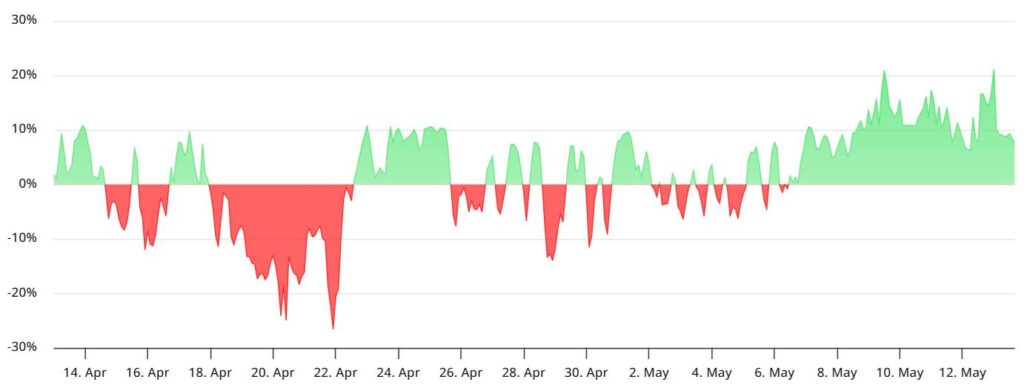In a significant development within the cryptocurrency landscape, Solana’s total value locked (TVL) has soared to an impressive $10.9 billion, eclipsing the total combined TVL of Ethereum’s layer-2 solutions such as Base, Arbitrum, and Avalanche. This remarkable milestone underscores Solana’s growing dominance in the decentralized finance (DeFi) sector.
Over the past month, the Solana network has witnessed a staggering 109% increase in fee revenue, reaching $43.4 million, further emphasizing the rising interest and activity surrounding its ecosystem. Coinciding with a broader altcoin rally, Solana’s native token, SOL, surged by nearly 25% earlier in May, fueled by Bitcoin surpassing the $100,000 mark. Despite some recent fluctuations in SOL’s price, the overall momentum remains hopeful, with on-chain data suggesting potential for further upward movement.
“With 65% of the SOL supply currently staked, the active engagement from holders supports bullish sentiments on the network.”
Noteworthy growth has been recorded among various Solana projects, with Raydium DEX, Jito liquid staking, and Marinade all reporting remarkable increases in their respective TVLs. In terms of diverse revenue sources, Solana’s DApps are showing consistent improvement, nearing their highest revenue levels in three months. In contrast, while Ethereum recorded just $24.9 million in base layer fees during a recent 30-day period, Solana has managed to carve out a more substantial revenue stream.
Investors and traders are keeping a keen eye on the SOL perpetual futures funding rate, which currently stands at 8%. This indicates a healthy demand from buyers looking to hold their positions in the market. With Solana still trading significantly below its all-time high of $295, some analysts speculate that catalysts such as a potential spot Solana ETF or advancements in traditional asset tokenization could further stimulate demand and price appreciation for SOL.
As Solana continues to capture attention in the rapidly evolving world of cryptocurrencies, these developments present a vibrant picture of a network poised for growth and enhanced visibility in the DeFi arena.
Key Takeaways from Solana’s Recent Market Performance
Understanding the latest developments in Solana can significantly impact your investment decisions in the cryptocurrency market. Here are the key points to consider:
- Surpassing Ethereum Layer-2 Ecosystem:
Solana’s total value locked (TVL) reached $10.9 billion, outperforming the entire Ethereum layer-2 ecosystem. This indicates a strong position in the market.
- Significant Increase in Fee Revenue:
Solana’s fee revenue rose 109% in the last month, totaling $43.4 million. Higher fees can drive demand for the SOL token, impacting its price positively.
- Healthy Funding Rate:
The current funding rate for SOL is 8%, indicating strong leverage demand from bulls, which suggests confidence in SOL’s potential for price increases.
- Recent Surge in Token Value:
SOL surged by 24.8% from May 6 to May 10, benefiting from a broader altcoin market rally. Monitoring price trends can help investors make timely decisions.
- Growth in Decentralized Finance (DeFi):
Key projects like Raydium DEX and Jito liquid staking have seen impressive TVL increases of up to 78%, indicating a robust growth in Solana’s ecosystem.
- Comparison with Competing Chains:
While Solana leads in several on-chain metrics, its competitors such as Binance Smart Chain and Tron are falling behind in TVL, which may influence investor sentiment.
- Potential Price Catalysts:
Market analysts suggest that factors like the approval of a Solana ETF and traditional asset tokenization could be key in driving SOL’s price even higher.
This article serves as a reminder that cryptocurrency markets are volatile. Always perform due diligence before making investment decisions.
The Surging Momentum of Solana: A Deep Dive Into Its Competitive Edge
In recent weeks, Solana has made headlines for an impressive leap that places it firmly in the spotlight of the cryptocurrency arena. With a total value locked (TVL) of $10.9 billion, Solana outpaces the combined efforts of Ethereum’s layer-2 solutions as well as the BNB Chain. This remarkable milestone highlights Solana’s robust growth in the decentralized finance (DeFi) sector, positioning it as a formidable player against rivals like Ethereum and Tron, which are known for their extensive smart contract capabilities.
Competitive Advantages: Solana’s recent 109% surge in fee revenue is a testament to its increasing traction among users, resulting in heightened demand for its native token, SOL. While the Ethereum network struggles with a mere $24.9 million in fees, Solana’s impressive $43.4 million demonstrates its ability to attract significant transactional activity. Coupled with substantial gains in decentralized applications (DApps) like Raydium, Jito, and Marinade, which have collectively seen TVL increases of 56% to 78%, Solana’s ecosystem is clearly thriving. This growth indicates not just volume but the rising trust and engagement from its user base, which could translate into long-term success.
Potential Disadvantages: While Solana’s metrics are on the rise, the cryptocurrency market is notoriously volatile. SOL is currently trading significantly below its all-time high, which could breed skepticism among new investors. Furthermore, the 8% funding rate for SOL futures suggests cautious optimism rather than overwhelming bullish sentiment. A funding rate on the higher side typically indicates robust long-position demand, but with the price still considerably down from its peak, Solana’s momentum could face obstacles if broader market conditions shift unfavorably.
As Solana continues to grow, it could provide substantial benefits for traders looking for high-volatility opportunities. Investors interested in DeFi projects may find Solana’s ecosystem attractive due to its lower fees and higher returns compared to competitors. However, existing holders of Ethereum or Tron might feel competitive pressure as Solana encroaches on their market share, potentially leading to a reassessment of their investments. Additionally, institutions eyeing the launch of spot ETFs focused on Solana could signal big money entering the space, which might further amplify SOL’s position in the market.
In summary, while Solana exhibits several competitive advantages, particularly in terms of user engagement and transaction reliability, it must navigate the inherent risks of a fluctuating market. The next few months will be crucial as investors and lifestyle enthusiasts alike watch closely to decipher whether Solana’s bullish trajectory will continue amidst the growing hype for altcoins.

















